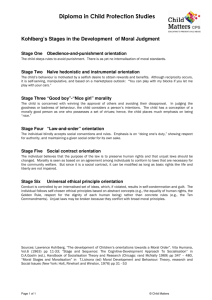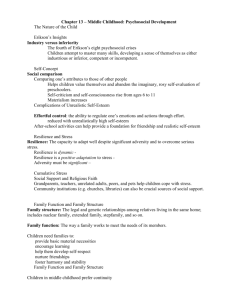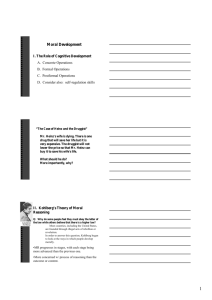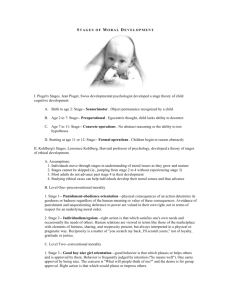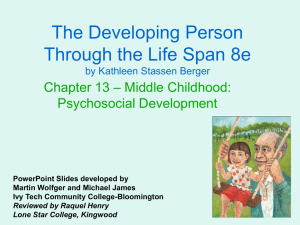PPT
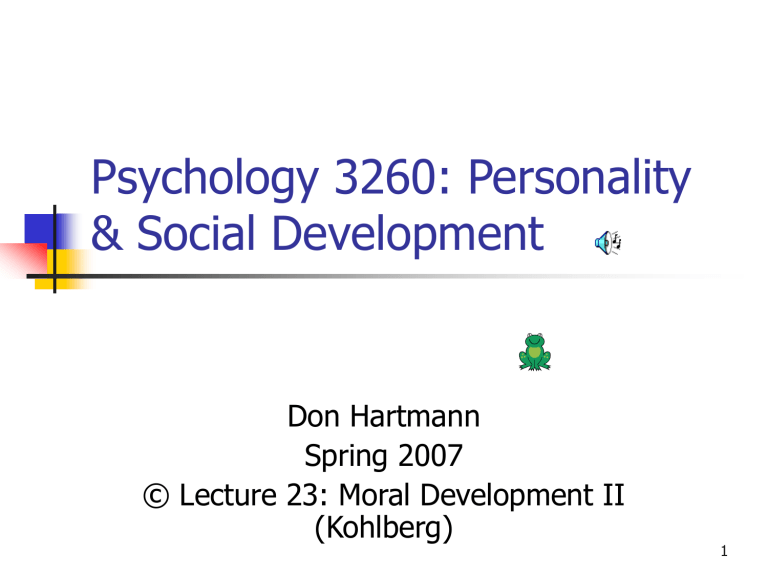
Psychology 3260: Personality
& Social Development
Don Hartmann
Spring 2007
© Lecture 23: Moral Development II
(Kohlberg)
1
Interesting Moral Socialization
2
Moral Development
Text Overlap: Pp. 323-332
Lecture: Cognitive-Developmental
Theory (Moral Thinking)
Introduction
Kohlberg: The 3 Ways
Evaluation of Kohlberg
Gilligan’s Theory Of Female Moral
Reasoning
Next: #24: Families--Parenting
3
Moral Reasoning: Introduction
Piaget got the ball rolling!
Moral reasoning a derivative of his theory of cognitive development
Three stages:
Premoral
Heteronomous morality (Moral realism)
Autonomous morality (Moral relativism)
4
Kohlberg’s Refinements: I
Three levels each with two stages
Preconventional:
1.
2.
Punishment & Obedience
Orientation
Naïve Hedonism
5
Kohlberg’s Refinements: II
Conventional:
3.
4.
Person Orientation
Social-Order Maintaining
Postconventional: morality of selfaccepted moral principles:
5.
6.
Social Contract Orientation
Individual Principles of Conscience
6
Whose kind of morality?
7
Tests of Kohlberg
Generally supportive results:
Individuals progress pretty much in the that Kohlberg theorized order
Few people progress beyond the conventional level, and in some underdeveloped countries individuals, particularly those from rural villages, show no evidence of postconventional moral reasoning. This may be due to limitations in schooling.
Formal operational thought is necessary , though not sufficient for post conventional moral reasoning
8
Tests of Kohlberg
Generally unsupported results:
Moral development seems not to be based on universal principles, but instead is at least partly contextually (e.g., culturally) defined
Gender biased: The average guy is at stage 4
(authority and social-order-maintaining) and gal at stage 3 (good boy or good girl orientation).
Does this mean that boys are more moral than girls?.
9
And here she is…
10
Gilligan’s Feminist
Concerns
The manner in which we socialize girls & boys results in differences in the manner in which they reason about moral issues:
boys being more oriented to rules and
girls to relationships.
Because Kohlberg was a male, used only boys in developing his stages, and used their performance to develop his scoring, he interpreted stage 3 as being less sophisticated than stage 4 -rather than merely different.
Gilligan, in a study of pregnant females found 3 levels of CARE with each level representing a more complex understanding of the relationship between one’s own perspective and the rights and concerns of others.
11
Gilligan’s Stages of Care
Perspective
12
Not the Utah Legislature!
13
Summary of Moral-Reasoning
II Lecture
Cognitive-Developmental Theory
(Moral Thinking): Kohlberg
Tests of Kohlberg
Gilligan’s Theory Of Female Morality
Next: #27 Families: Parenting
Go in Peace
14

